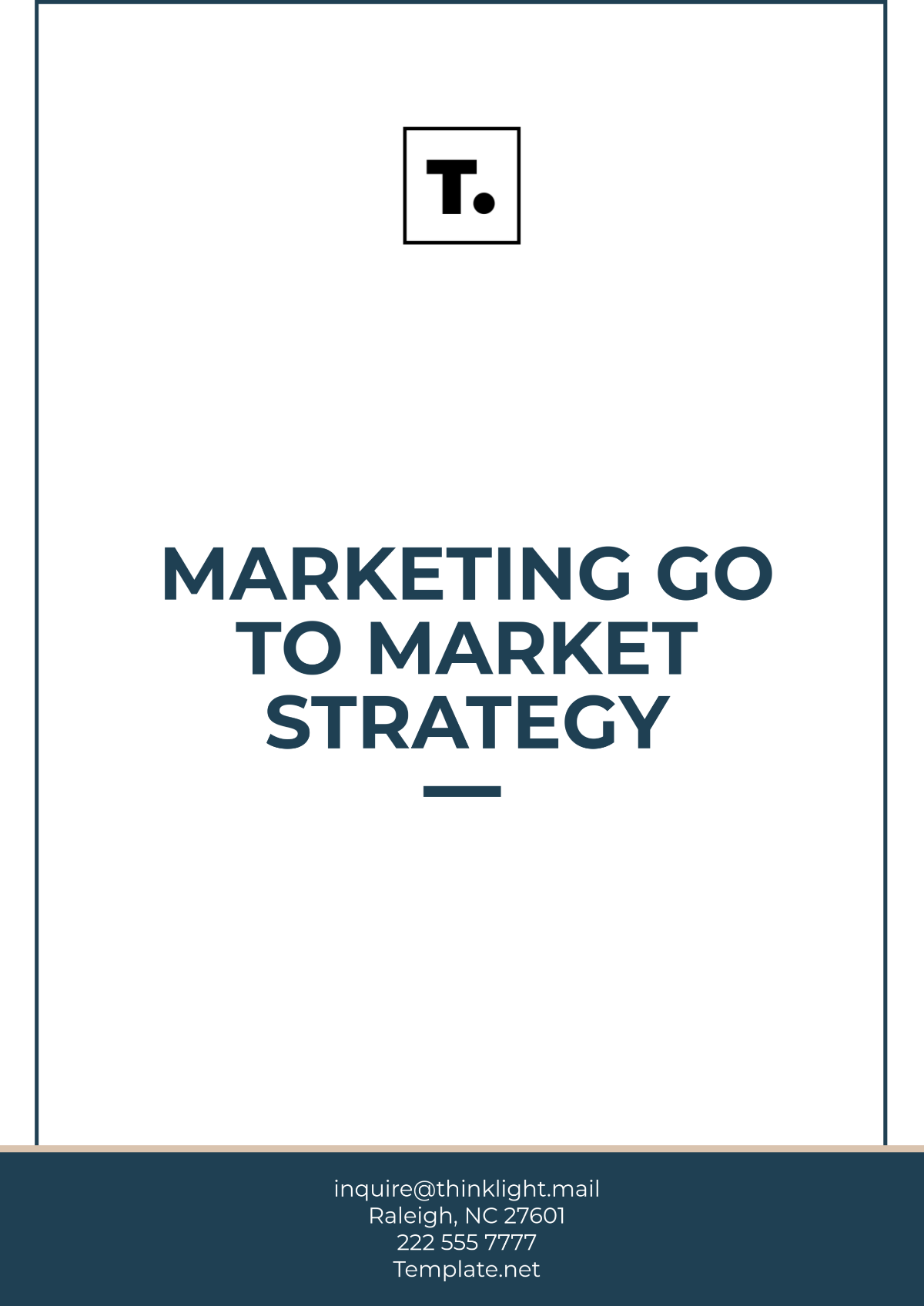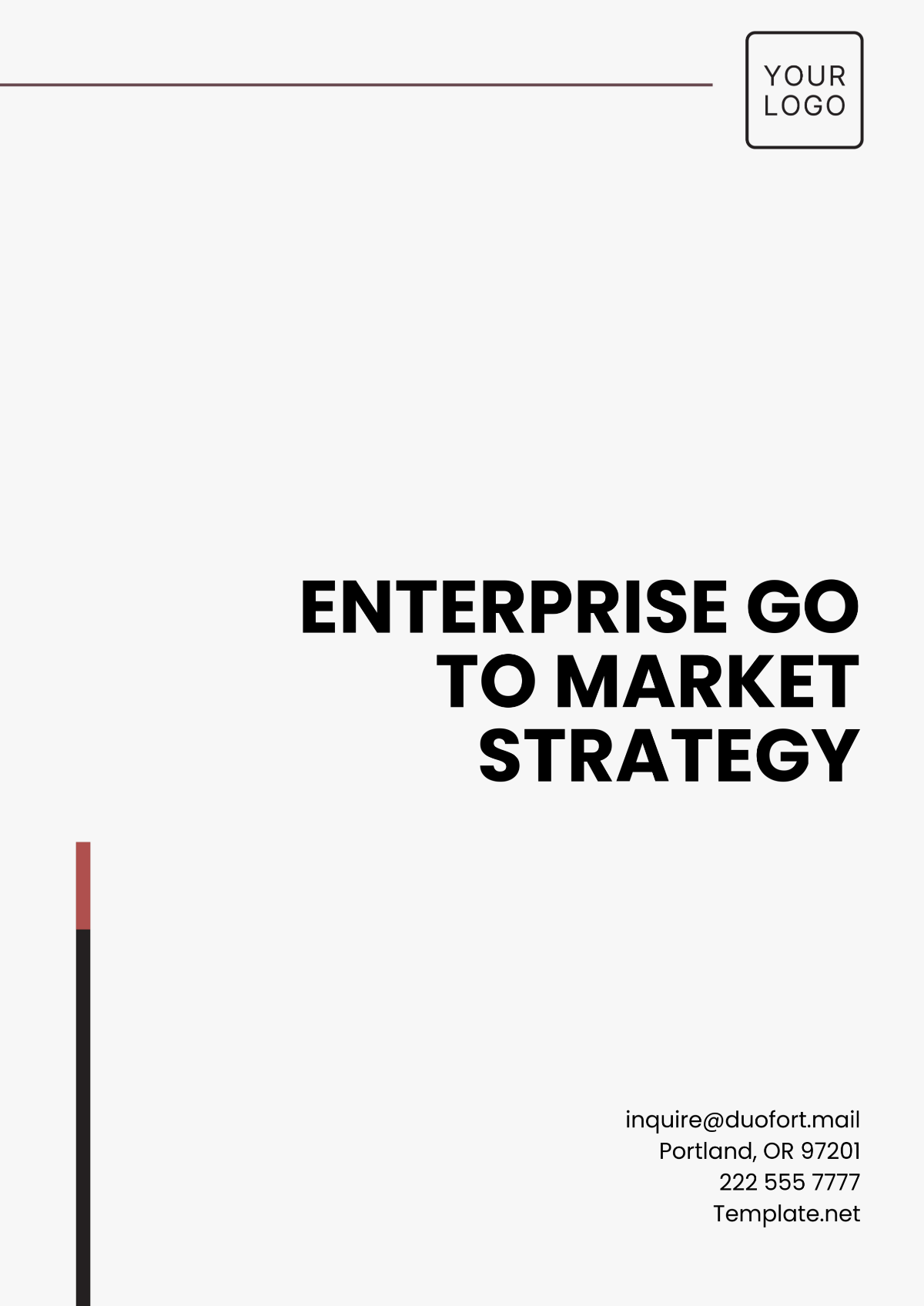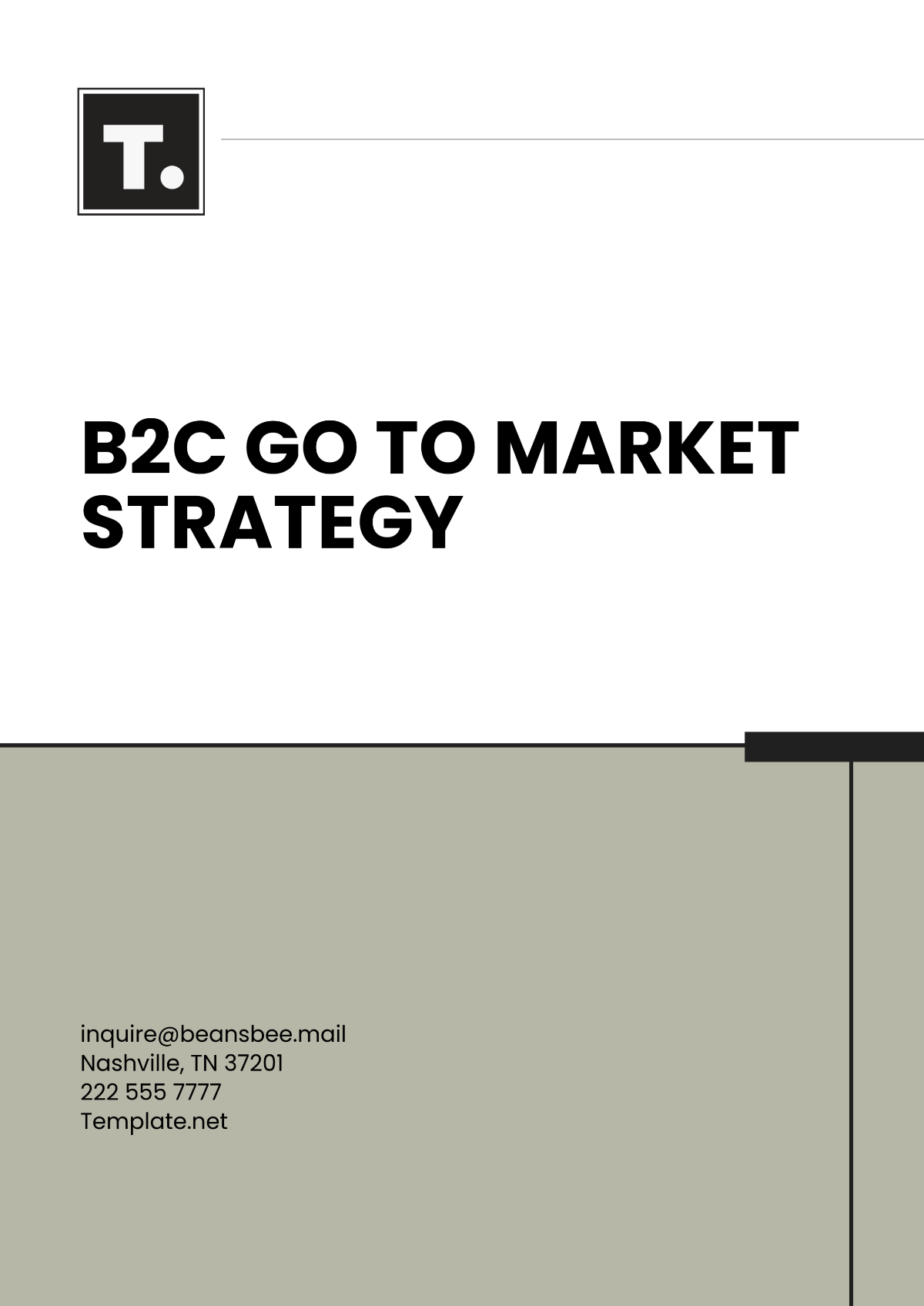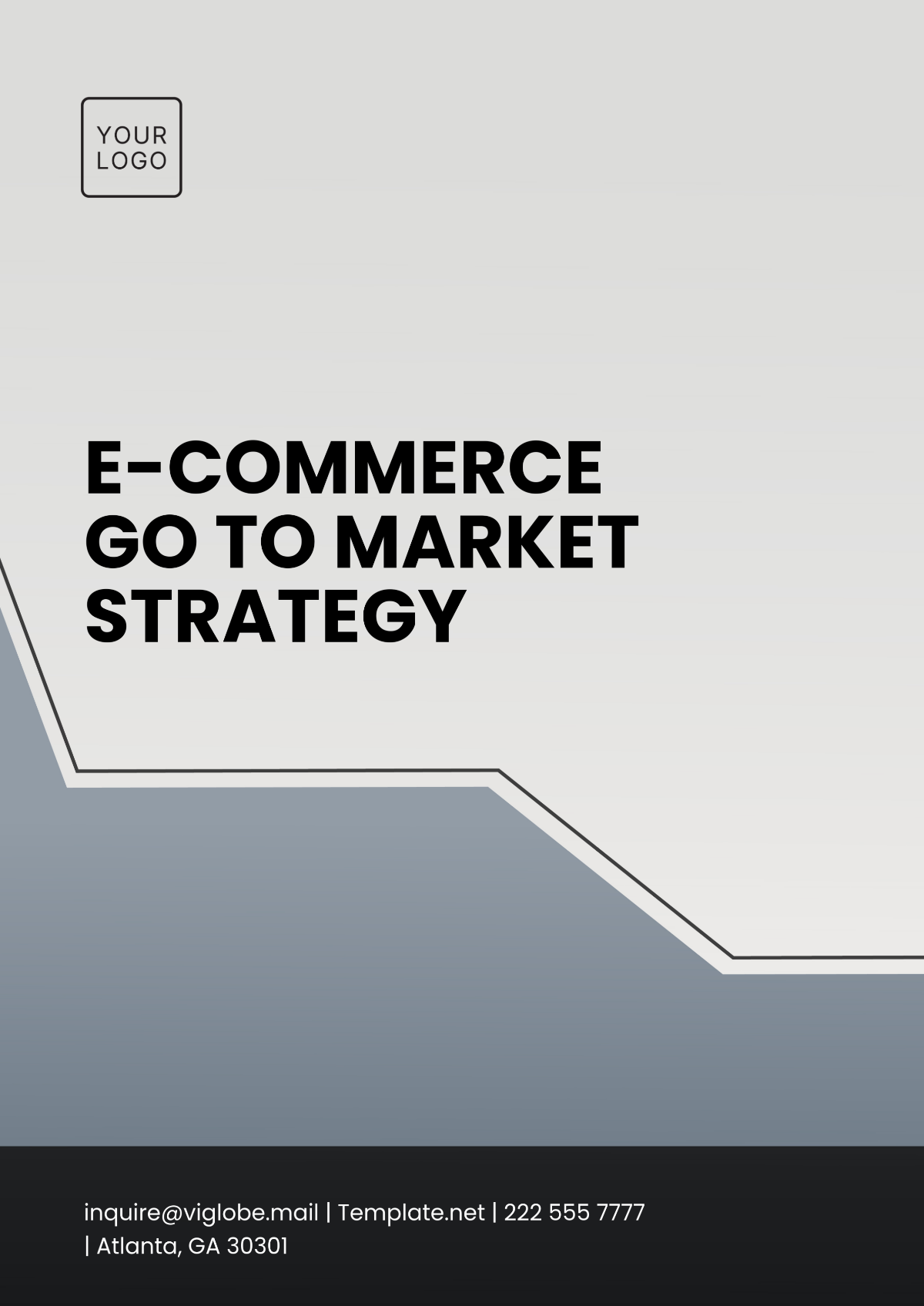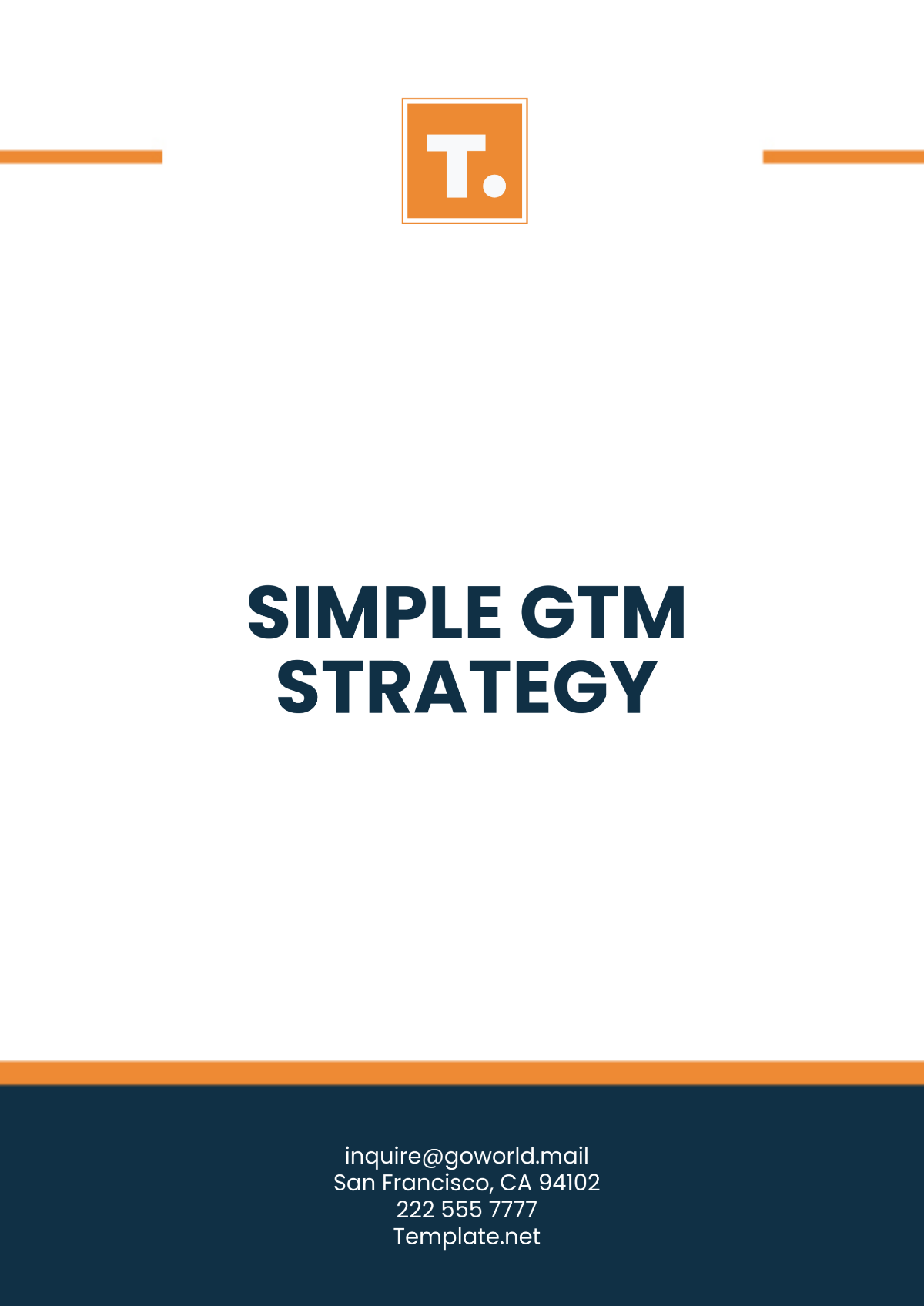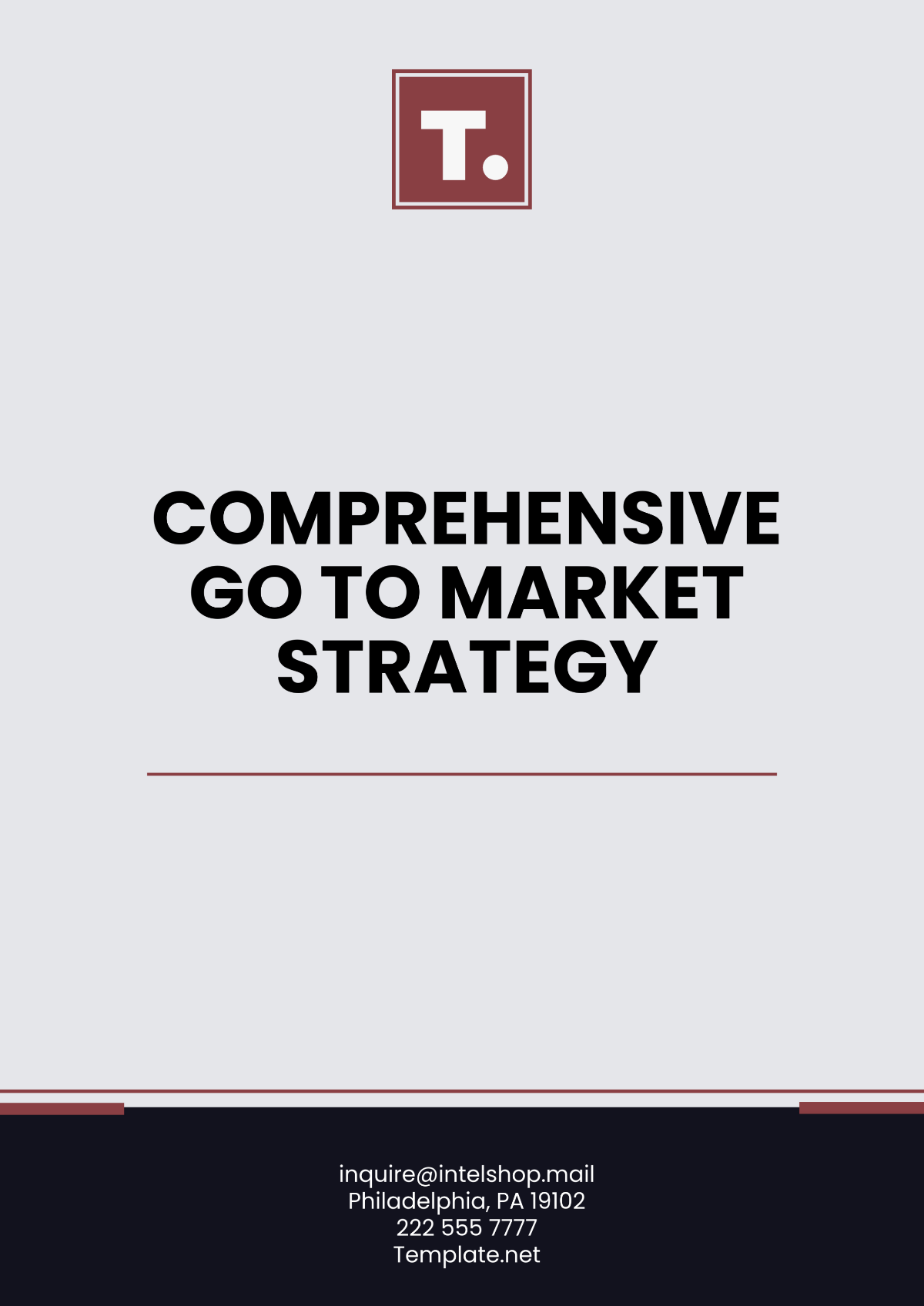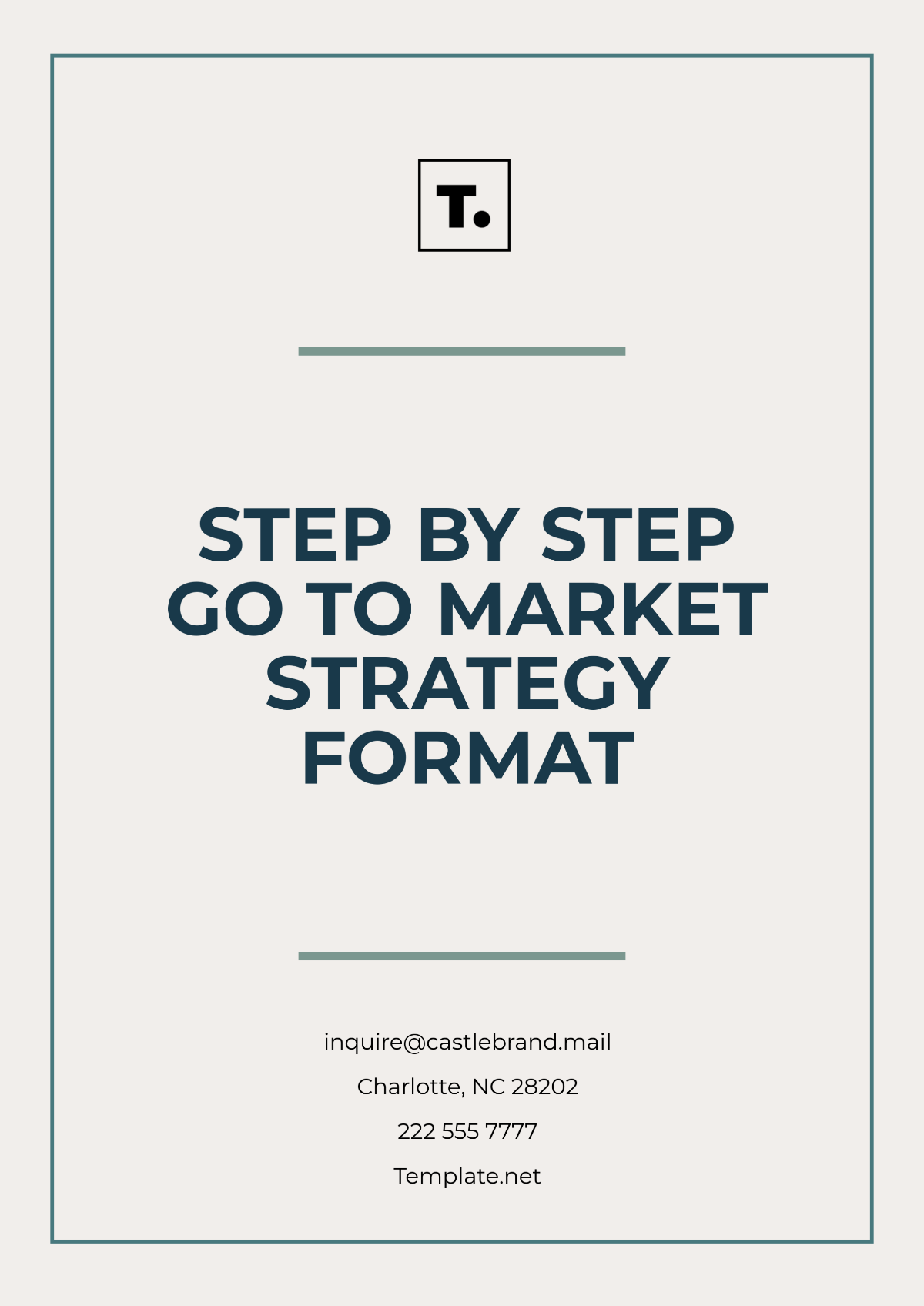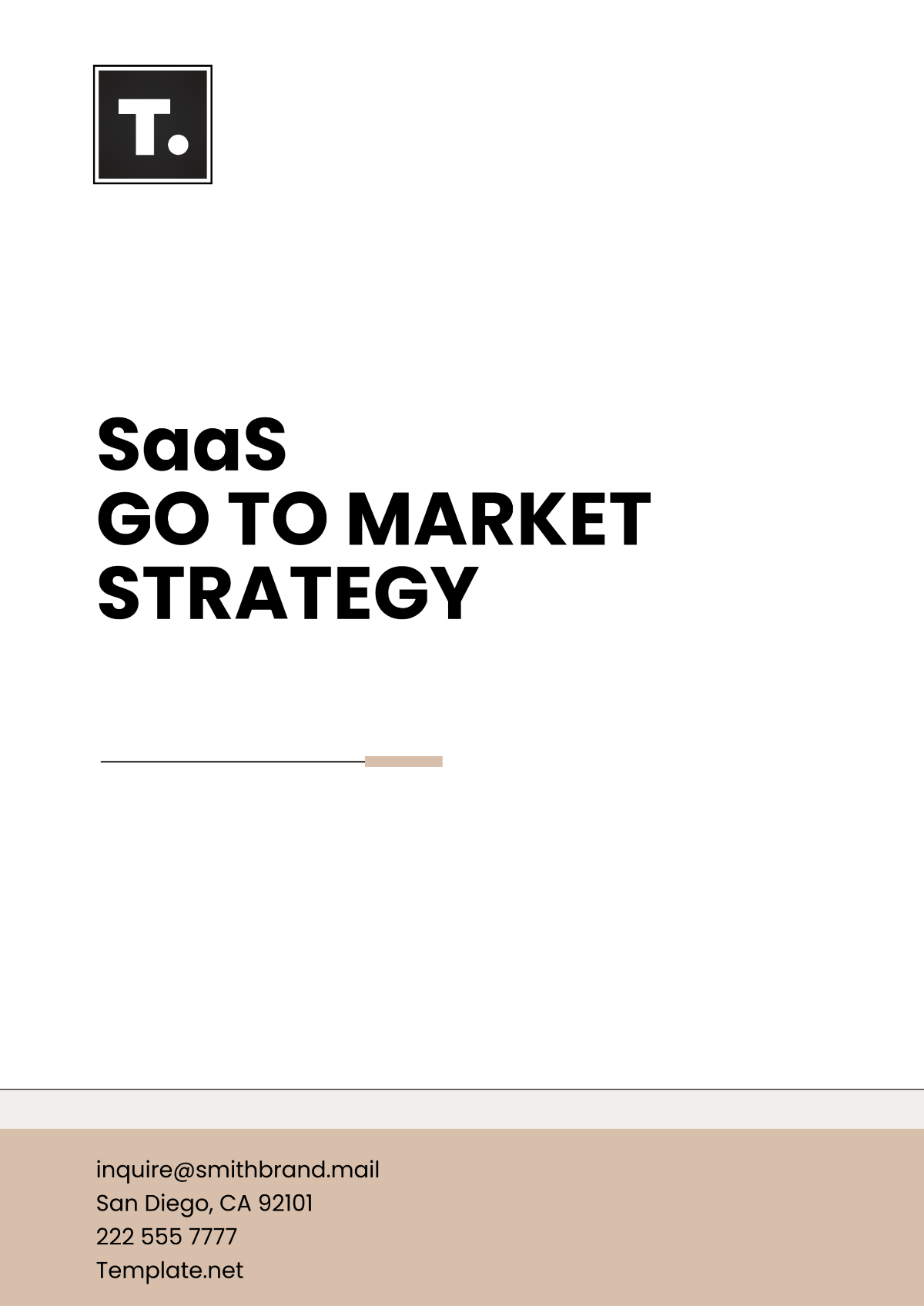Go-to-Market Business Model
1. Introduction
Establishing a robust Go-to-Market (GTM) strategy is critical for [Your Company Name] to successfully launch products and services. A well-defined GTM model serves as the foundation for acquiring customers, generating revenue, and sustaining growth in a competitive environment. As we look ahead to the year 2050 and beyond, businesses must not only respond to current trends but also anticipate future market dynamics. This document outlines the comprehensive GTM business model tailored for [Your Company Name], including market analysis, positioning, pricing strategy, distribution channels, marketing tactics, sales strategy, and metrics for success.
2. Market Analysis
2.1. Industry Overview
In 2050, the global market is characterized by rapid technological advancements, shifting consumer behavior, and increasing competition across various sectors. The emergence of artificial intelligence, machine learning, and automation has fundamentally transformed industries, necessitating that [Your Company Name] adapts its strategies to leverage these technologies effectively. Furthermore, changing demographics and preferences demand innovative approaches to product development and customer engagement.
Table 1: Key Industry Trends for 2050
Trend | Description |
|---|---|
Artificial Intelligence (AI) | AI is revolutionizing product development, customer service, and marketing automation, enabling businesses to offer personalized experiences and streamline operations. |
Personalization | Consumers increasingly expect tailored experiences based on their individual preferences, driving companies to invest in data analytics and customer insights to meet these demands. |
Sustainability | A growing focus on eco-friendly products and practices is essential as consumers become more environmentally conscious, prompting businesses to adopt sustainable practices. |
Remote Work | The rise of remote work necessitates digital solutions for communication, collaboration, and productivity, as more employees seek flexibility in their work arrangements. |
Globalization | Businesses are expanding their reach across borders, requiring an understanding of local markets and cultures to successfully penetrate diverse consumer bases. |
2.2. Target Market
Understanding the target market is paramount for [Your Company Name] to develop products and services that meet specific customer needs. By identifying the primary audience, we can tailor our offerings to ensure relevance and appeal.
2.2.1. Market Segmentation
Market segmentation allows [Your Company Name] to categorize potential customers based on various criteria. This segmentation enables targeted marketing efforts and helps focus resources on the most promising market segments. The following segments are identified for [Your Company Name]:
Demographic Segmentation: Age, gender, income, education level, and occupation are crucial factors that influence purchasing decisions. For instance, targeting millennials may require different marketing approaches compared to older generations.
Geographic Segmentation: This involves categorizing consumers based on their location, including regions, countries, and cities where the products will be marketed. Understanding local cultures and preferences is essential for successful market penetration.
Psychographic Segmentation: This approach looks at the lifestyle, values, interests, and attitudes of potential customers. By aligning our products with the values of target audiences, we can foster deeper connections.
Behavioral Segmentation: This includes analyzing purchase behavior, brand loyalty, and product usage patterns. Understanding these behaviors enables [Your Company Name] to optimize its offerings and marketing tactics.
Table 2: Target Market Segmentation
Segment | Description | Size (Estimated) |
|---|---|---|
Millennials | Tech-savvy individuals aged (25-40) who value innovation and experiences. | [500 million] |
Gen Z | Younger consumers aged (18-24) who are digital natives and prioritize authenticity. | [300 million] |
Professionals | Working adults in various industries seeking efficiency solutions to enhance productivity. | [1 billion] |
Eco-conscious consumers | Customers prioritizing sustainable products and ethical practices, often willing to pay more for them. | [400 million] |
2.3. Competitive Analysis
Understanding the competitive landscape is vital for [Your Company Name] to identify opportunities and threats. A thorough analysis will help define our unique value proposition (UVP) and position in the market.
2.3.1. Competitor Identification
Competitors can be classified into direct, indirect, and emerging players within the market. Direct competitors offer similar products, while indirect competitors may provide alternative solutions that fulfill the same customer needs. Emerging players include startups and innovators disrupting the market with fresh ideas and approaches.
Table 3: Competitor Overview
Competitor Name | Type | Strengths | Weaknesses |
|---|---|---|---|
Company A | Direct | Strong brand recognition and established market presence, allowing for customer trust. | Higher price points that may deter price-sensitive customers. |
Company B | Indirect | Diverse product portfolio that caters to various consumer needs, providing multiple options. | Weak customer service reputation, leading to potential dissatisfaction. |
Company C | Emerging | Innovative technology and disruptive business models that appeal to younger demographics. | Limited market presence and brand awareness compared to established players. |
3. Positioning
3.1. Unique Value Proposition (UVP)
The Unique Value Proposition articulates what differentiates [Your Company Name] from competitors and why customers should choose our products or services. It must resonate with the target audience and effectively address their pain points.
3.1.1. Crafting the UVP
Creating a compelling UVP involves several key components:
Clarity: The UVP should clearly state the benefits of the product and its relevance to the target audience. It should answer the question: "Why should customers choose us?"
Differentiation: Highlight what makes [Your Company Name] unique in the market. This could include innovative features, superior quality, or exceptional customer service.
Credibility: Provide proof points or testimonials to support claims made in the UVP. Case studies, user reviews, and expert endorsements can bolster credibility.
3.2. Brand Positioning
Brand positioning is about creating a distinct image of [Your Company Name] in the minds of consumers. It encompasses various elements, including branding, messaging, and customer experience. A strong brand position enhances recognition and loyalty.
3.2.1. Positioning Strategies
Quality Leadership: Position [Your Company Name] as a leader in quality and innovation, emphasizing rigorous standards in product development and customer satisfaction.
Customer-Centric Approach: Emphasize a commitment to exceptional customer service and personalized experiences, ensuring that every interaction reflects our dedication to the customer.
Sustainability: Highlight eco-friendly practices and sustainable product offerings, appealing to the growing segment of environmentally conscious consumers.
Table 4: Positioning Matrix
Positioning Strategy | Target Audience | Key Message |
|---|---|---|
Quality Leadership | Professionals | "The best products for the discerning customer, delivering unmatched quality." |
Customer-Centric Approach | Eco-conscious consumers | "We prioritize your needs at every step of the journey, from purchase to support." |
Sustainability | Millennials & Gen Z | "Eco-friendly choices for a better planet, because your values matter." |
4. Pricing Strategy
4.1. Pricing Models
Choosing the right pricing model is critical for [Your Company Name] to remain competitive while achieving profitability. Various models may be employed depending on market dynamics and customer preferences, and the right approach will depend on our strategic goals.
4.1.1. Common Pricing Models
Cost-Plus Pricing: This traditional method involves calculating total costs and adding a markup for profit. While straightforward, it may not always reflect the value perceived by customers.
Value-Based Pricing: This strategy sets prices based on the perceived value to customers rather than solely on costs. This requires in-depth understanding of customer needs and competitive positioning.
Dynamic Pricing: Adjusting prices based on demand fluctuations and market conditions can optimize revenue. This model is particularly effective in industries like travel and e-commerce.
4.2. Pricing Strategy Implementation
The implementation of a pricing strategy involves considerations around pricing tiers, discounts, and promotional offers that attract different customer segments while maintaining profitability.
Table 5: Pricing Structure Example
Pricing Model | Description | Example Price |
|---|---|---|
Basic | Standard features and customer support included. | [$99]/month |
Pro | Additional features and priority support for enhanced performance. | [$199]/month |
Enterprise | Custom solutions tailored for larger organizations with unique needs. | Custom pricing |
4.3. Price Testing and Adjustment
Continuous monitoring and analysis of pricing effectiveness will be essential for [Your Company Name]. Regular A/B testing will help determine optimal price points, and adjustments should be made based on customer feedback, market trends, and competitor actions.
5. Distribution Channels
5.1. Channel Strategy
Identifying the appropriate distribution channels is essential for reaching the target market effectively. A multi-channel approach can increase visibility and customer engagement while providing multiple touchpoints for potential buyers.
5.1.1. Direct vs. Indirect Channels
Direct Channels: Selling products directly to consumers through the company website or physical stores allows for greater control over branding and customer experience. Direct sales often yield higher margins and better customer relationships.
Indirect Channels: Utilizing third-party distributors, retailers, or wholesalers can expand market reach and leverage existing relationships in the industry. This approach often requires partnerships and commissions but can quickly scale sales volume.
Table 6: Distribution Channel Overview
Channel Type | Description | Benefits |
|---|---|---|
Direct Sales | Selling directly through the company’s website or stores. | Higher profit margins, direct customer relationships. |
E-commerce Platforms | Utilizing platforms like Amazon or eBay for broader reach. | Access to larger audiences and established trust. |
Retail Partnerships | Collaborating with retail stores to sell products. | Increased visibility and convenience for customers. |
5.2. Distribution Strategy Execution
The execution of the distribution strategy involves developing partnerships, setting up logistics, and ensuring timely delivery of products to customers. Attention to detail in this phase is essential to maintaining customer satisfaction and meeting market demands.
6. Marketing Strategy
6.1. Integrated Marketing Communications
An integrated marketing communications strategy ensures that all messaging and channels work together harmoniously. This alignment amplifies brand awareness and reinforces [Your Company Name]'s value proposition across various platforms.
6.1.1. Key Components of Integrated Marketing
Advertising: Strategic ad placements across digital and traditional channels to reach target audiences effectively. Utilizing data analytics to optimize campaigns will maximize ROI.
Content Marketing: Developing high-quality content that addresses customer pain points and builds brand authority. This includes blogs, whitepapers, case studies, and videos.
Public Relations: Building relationships with media outlets and influencers to enhance brand reputation and generate buzz around new products or initiatives.
Table 7: Integrated Marketing Communication Channels
Channel | Purpose | Strategy |
|---|---|---|
Social Media | Engage with customers and build community. | Regular posts, promotions, and interaction. |
Email Marketing | Nurture leads and communicate with existing customers. | Targeted campaigns based on user behavior. |
Webinars | Educate potential customers about products. | Hosting informative sessions that showcase expertise. |
6.2. Digital Marketing Strategy
In the digital age, an effective digital marketing strategy is paramount for [Your Company Name] to reach and engage potential customers. This includes leveraging various online platforms and technologies to build brand awareness and drive conversions.
6.2.1. Search Engine Optimization (SEO)
Implementing robust SEO practices will enhance visibility on search engines, driving organic traffic to [Your Company Name]'s website. This includes keyword optimization, content creation, and technical SEO improvements.
6.2.2. Pay-Per-Click (PPC) Advertising
PPC advertising enables [Your Company Name] to reach potential customers actively searching for products or services. A well-structured PPC campaign can provide immediate visibility and targeted traffic, resulting in quick ROI.
6.2.3. Social Media Marketing
Social media platforms provide excellent opportunities for [Your Company Name] to connect with its audience, share content, and promote products. An effective strategy involves regular engagement, strategic posting schedules, and targeted advertising to maximize reach.
7. Sales Strategy
7.1. Sales Organization
An effective sales organization structure is crucial for [Your Company Name] to achieve its sales goals. The organization should align with the overall GTM strategy while fostering a culture of collaboration and success.
7.1.1. Sales Roles and Responsibilities
Clearly defining sales roles and responsibilities is essential for accountability and effectiveness in driving revenue. The following roles will be established:
Sales Representatives: Responsible for prospecting, qualifying leads, and closing deals. They serve as the primary point of contact for potential customers and play a critical role in converting leads into sales.
Account Managers: Focus on maintaining and nurturing relationships with existing customers, ensuring their needs are met and identifying opportunities for upselling or cross-selling.
Sales Engineers: Provide technical support and product expertise during the sales process, addressing customer inquiries and demonstrating product capabilities effectively.
7.2. Sales Process
Establishing a clear sales process ensures consistency and effectiveness in converting leads into customers. A well-defined sales funnel provides a roadmap for guiding prospects through their buying journey.
7.2.1. Sales Funnel Stages
Understanding the sales funnel stages enables [Your Company Name] to craft targeted marketing strategies that resonate with customers at each point of their journey.
Awareness: Attracting potential customers through marketing efforts. This stage involves creating awareness about the brand and product offerings to engage potential buyers.
Interest: Engaging prospects with valuable content and communication that piques their curiosity and encourages them to explore further.
Decision: Providing the necessary information and support to facilitate purchasing decisions. This includes demos, consultations, and answering any questions or objections customers may have.
Action: Closing the sale and onboarding the customer. This stage focuses on finalizing the sale and ensuring a smooth transition into the customer experience.
Table 8: Sales Funnel Overview
Stage | Description | Key Actions |
|---|---|---|
Awareness | Prospects discover [Your Company Name] | Marketing campaigns, social media presence, partnerships with influencers to increase visibility. |
Interest | Prospects show interest in products | Webinars, content downloads, targeted email campaigns, and personalized follow-ups. |
Decision | Prospects evaluate and consider options | Demos, consultations, case studies showcasing product success, and tailored proposals. |
Action | Customers make a purchase | Order processing, onboarding, and ensuring customer satisfaction through follow-ups. |
8. Metrics for Success
8.1. Key Performance Indicators (KPIs)
Defining metrics for success is critical to measure the effectiveness of the GTM strategy. The following KPIs will be tracked and analyzed regularly to assess progress toward goals.
Customer Acquisition Cost (CAC): The total cost associated with acquiring a new customer, including marketing, sales, and overhead costs. Reducing CAC over time is vital for increasing profitability.
Customer Lifetime Value (CLTV): The total revenue expected from a customer throughout their engagement with [Your Company Name]. Maximizing CLTV should be a primary focus, as it represents long-term profitability.
Sales Growth Rate: The percentage increase in sales revenue over a specified period, typically measured on a monthly or quarterly basis. Consistent sales growth is an indicator of a successful GTM strategy.
Conversion Rate: The percentage of leads that convert into paying customers, which is critical for evaluating the effectiveness of marketing and sales efforts. Improving conversion rates can lead to substantial revenue growth.
Table 9: KPIs Overview
KPI | Description | Target |
|---|---|---|
Customer Acquisition Cost | Total cost of acquiring a new customer | <[$100] |
Customer Lifetime Value | Total revenue from a customer during their lifetime | >[$1,000] |
Sales Growth Rate | Percentage increase in sales year-over-year | >[20%] |
Conversion Rate | Percentage of leads converted into customers | >[10%] |
8.2. Performance Review
Regular performance reviews will ensure that [Your Company Name] remains on track to achieve its objectives. Quarterly assessments will allow for timely adjustments to the GTM strategy based on real-time data. In addition, annual reviews will provide a broader perspective on market trends and changes in customer behavior, enabling proactive strategy modifications.






